 Remington produced Remington Express Accelerator ammo over a span of three decades. The pitch was that the use of this product would allow 30-06 Springfield, 308 Winchester and 30-30 WCF owners to use their deer rifles for off season varmint hunting and therefore increase rifle utility. The ammunition was universally loaded with a sabot mounted, 55 grain, 0.224″ Remington PSP bullets. In descending order of performance:
Remington produced Remington Express Accelerator ammo over a span of three decades. The pitch was that the use of this product would allow 30-06 Springfield, 308 Winchester and 30-30 WCF owners to use their deer rifles for off season varmint hunting and therefore increase rifle utility. The ammunition was universally loaded with a sabot mounted, 55 grain, 0.224″ Remington PSP bullets. In descending order of performance:
| Cartridge | Muzzle Velocity |
Production Dates |
| 30-06 Springfield | 4,080 | 1977-2011 |
| .308 Winchester | 3,770 | 1980-1995 |
| .30-30 WCF | 3,400 | 1979-1996 |
The high velocity sabot mounted .22 caliber bullet would clear the rifle’s muzzle, quickly shed its sabot and, with a ballistic coefficient and sectional density suitable for long range shooting, it would continue on to its target1) 2). The cartridge pictured left is actually a handload of construction similar to the Remington Accelerator. The demise of Accelerator ammunition has been attributed to many things, some straight forward, some surreptitious in nature.
In checking in with the nice folks at Remington, the official reason for eventually dropping the Accelerator was decreasing demand and difficult to manufacturer. I would dismiss the often parroted notion that Remington was pressured by the Federal government to withdraw the product because the bullet was not marked by rifling as it passed through a rifle’s bore as the same applies to every shotgun and muzzle loader that routinely utilizes sabot mounted projectiles. Less inspired, but no doubt closer to the truth, the ever growing wide spread availability of low cost .223 Remington firearms and ammunition, as well as other small bore combinations made Accelerator ammunition a less attractive alternative. The last supply of Remington Express 30-06 Springfield Accelerator inventory was listed on Midway USA on October 10, 2013 with a price tag of $44.99 for a box of twenty rounds. During the same period, inexpensive .223 Remington ammo was priced below $5 per box of twenty.
In addition to the negative aspect of high cost, there was also an issue of inaccuracy. While the concept of employing sabot-mounted projectiles in sporting firearms has been well proven in many sporting arms applications, the field reported levels of performance for the Accelerator product varied significantly. Based upon personal experience with the product, I believe this problem probably resides with the firearm, more than with the ammunition.
There are many ways to skin a cat… all of them painful to the cat
 The accuracy of typical deer hunting rifles, new and older but still in service, during the late 70’s and early 80’s when the Accelerator ammunition’s reputation was formed, was something on the order of 1.5″ to 2″ groups at 100 yards, progressing to approximately 4.5″ to 6″ groups at 300 yards where a good deal of varmint hunting occurred. This level of accuracy was absolutely adequate for game with dinner plate size kill zones, but not for game with a tennis ball size kill zone. It would be no fun shooting along side of a buddy with a heavy barrel .22 caliber centerfire varmint rifle that could shoot groups one third the size. The Accelerator ammo did not perform poorly as much as it was being used in rifles that were not built for long range precision shooting. Some things have changed to improve this situation.
The accuracy of typical deer hunting rifles, new and older but still in service, during the late 70’s and early 80’s when the Accelerator ammunition’s reputation was formed, was something on the order of 1.5″ to 2″ groups at 100 yards, progressing to approximately 4.5″ to 6″ groups at 300 yards where a good deal of varmint hunting occurred. This level of accuracy was absolutely adequate for game with dinner plate size kill zones, but not for game with a tennis ball size kill zone. It would be no fun shooting along side of a buddy with a heavy barrel .22 caliber centerfire varmint rifle that could shoot groups one third the size. The Accelerator ammo did not perform poorly as much as it was being used in rifles that were not built for long range precision shooting. Some things have changed to improve this situation.
Modern deer rifles reflect major accuracy improvements over the production rifles of even a single decade ago to the extent that 1/2 to 3/4 MOA performance is quite common. Since firearm mechanical accuracy improved, it seemed that revisiting the issue of .30 caliber sabot mounted .22 caliber bullets might yield substantially improved results. Unfortunately, the very high cost of NOS Remington Express Accelerator ammo precludes its use. Originally introduced with an MSRP of $8.85 per box of 20, the ammunition is now being sold as obsolete collectable for $3.75 – $5.75 per round. Fortunately, current manufacture .30 caliber sabot are readily available.
Anecdotally, the accuracy potential of handloaded .30 caliber sabot mounted projectiles can be seen in the incredible accuracy of other types of current production rifles. Sabots commonly used to mount shotgun slugs for use in rifled bores and for mounting sub-caliber bullets in muzzleloaders, often produce sub MOA accuracy. Recent work with a .50 caliber Remington Ultimate Muzzleloader resulted in sub MOA groups with sabot mounted .45 caliber projectiles at 100, 200 and 300-yards.
A plan was formulated to collect baseline performance data from a Remington Model 700 rifle chambered for the .30-06 Springfield, then move on and develop sabot mounted .224” bullet .30-06 Springfield handloads and to, finally, compare the accuracy of one ammunition type to the other. That said, in the words of Robert Burns, “The best laid schemes of mice and men…” Come to think of it, he also wrote My Lord A-Hunting… which actually has a lot less to do with hunting than one might suspect.
The perils of short legs and tall snow drifts
Writing about firearms in the winter time, and shooting outdoors in a year of record snowfall, requires perseverance. When you are mature. and no longer have children young enough to be bribed or tricked into running targets… you’re just out of luck. But then the exercise has got to be worth the effort. Sure.
The rifle selected for the project is a Remington Model 700 XCR II. We have worked with a number of them on other projects and they have always been accurate and able to stand up to heavy use. A basic, reliable scope was installed, a Burris FullField II 3-9x-40mmon Warne mounts and a Picatinny rail. Baseline ammo selection was Winchester 150 grain Super X, Remington Express 165 grain Core-Lokt and Hornady 150 grain Superformance SST.
Three, three shot groups were shot with each ammo type. The largest group size for each appears on the table below. temperature was 14ºF Humidity 64% 3 MPH Tail Wind. I need to move to Florida. In my little Joe universe, the Remington Model 700 proved to be an accurate sporting firearm, interesting enough to get me to sit still at an outdoor bench, ignore the weather and concentrate on trigger squeeze and fog producing breathing.
| Ammunition | Bullet Weight Grains |
Rated MV FPS |
Actual MV FPS |
100 Yd 3 Shot Group “ |
| Hornady Superformance SST | 150 | 3080 | 3047 | 0.9 |
| Remington Express Core-Lokt | 165 | 2800 | 2811 | 0.5 |
| Winchester Super X PP | 150 | 2920 | 2906 | 0.7 |
I believe we are back in a cycle of debating valid sampling to determine a rifle’s shot placement consistency, with 3 shot groups again catching rotten tomatoes, but not from me. Over the years, one shot kills have been the norm, two shots the exception and more shots were just never needed. Not a sign of a marksman as much as being conservative taking shots. On that basis, three shot groups are a more realistic simulation of my applications than would be shooting five shot or more qualifying groups.
One three shot group would not be enough of a sample to suggest a rifle’s field accuracy, but surely ten three shot groups make for a valid forecast, although, I can’t remember any surprise results after three sets of three shot groups, so… If one of the three shot groups results in an anomaly, more groups can be shot until the result becomes predictable.
Product marketing as wishful thinking…
Keeping prior Remington Accelerator shooting experience in mind, as well Remington’s assertion that Accelerator ammo would mimic a rifle’s accuracy with full caliber ammunition, the handloaded sabot ammunition results were less than exciting… way less than exciting. Using components and tools as received, with load data consistent with recommendations, resulted in the following:
| Ammunition | Bullet Weight Grains |
Rated MV FPS |
Actual MV FPS |
100 Yd 3 Shot Group “ |
| Remington PSP | 55 | 4200 | 3776 | 4.3 |
| Remington PSP | 55 | 4200 | 3486 | 3.9 |
| Remington PSP | 55 | 4200 | 3663 | 5.2 |
The truth of the matter is that I wasn’t surprised by the results . After handling the components, checking weights and dimensions, understanding the source of the handload “data”, the results were better than anticipated. Subsequently, the next step was to see how many of the detected problems were correctable and if these corrections would make a difference of consequence.
All sabots are not created equal, even by design…
The .30 caliber sabot design has little in common with highly successful muzzle loader sabot product, which means my anecdotal prediction of .30 caliber sabot accuracy was without substantial merit. Muzzle loader sabots have a skirt very similar to a shotgun shell gas seal; short, pliable and approximately 0.165″ deep that provides the primary bore seal. The three fingers that surround the shank of the projectile are thin and very flexible and only 0.022″ thick. Their principal job is to maintain projectile alignment in the bore.

By comparison, the .30 caliber sabot is flat based with a solid shank, not hollow based as defined in product literature. The 6 fingers are relatively thick and rigid, at 0.045″ more than twice the thickness of the .50 caliber sabots. Where aft pressure expands the base of the .50 caliber sabot to seal the bore and bore friction forces the flexible fingers into contact with the bore while centering the projectile, the .30 caliber sabot is a more of a sealing spacer. Where the .50 caliber sabot forms around the .45 caliber projectile, the .22 caliber bullet in the .30 caliber sabot is mostly just along for the ride. Late Remington Accelerator ammunition used a more pliable material than early production and the fingers retaining the bullet were thinned.
The .30 caliber sabots popularly sold on the Internet are repackaged from single source supply. In fact, some of the sabot specialty companies advertising on the Internet resolve to an apartment complex or residence on Google Street View. Not an indictment of a cottage industry, but rather an observation that a central injection molding shop makes the sabots and assembly tools in bulk, which are then repackaged and resold by enterprising folks or companies. The sabots and tools purchased for this project came from a number of resellers, all with material of comparable quality.
Focus, focus, focus…
The .30 caliber sabots are made of injection molded polyester resin compound with a nylon coupling agent; the parts can withstand temperatures up to 500ºF. Pictured below, they are actually not of the same configuration as the original Remington Express Accelerator sabot. They are a six retaining finger design, however, the Remington sabot weighed 7 grains and these range from 4.8 – 6.1 grains. In use, the leading edge of the Remington sabot was supposed to meet wind resistance and separate from the bullet within 14″ of the rifle’s muzzle. Both the sabot and bullet continue on, but the sabot will run out of gas within 50 to 100 feet while the bullet keep’s right on going.

The current sabot is presented as doing the same, however, the Remington sabot did not have fluted fingers like the current sabot (1). The assembly far left is utilizing the Remington 55 grain PSP type bullet as used in the original Accelerator loads. The bullet next to it is a Hornady Match 68 grain bullet. the sabots on the right (2) are part of the unusable short shot defects found in the package. This is an injection molding process management problem.
| Sample # | Weight Grains |
Heel Diameter |
Shank Diameter |
Length | Cavity Depth |
Cavity Diameter |
Short Shot |
| 1 | 5.9 | .309 | .308 | .535 | .423 | .223 | N |
| 2 | 4.8 | .306 | .306 | .445 | .351 | .224 | Y |
| 3 | 6.1 | .313 | .308 | .538 | .435 | .219 | N |
| 4 | 5.9 | .312 | .307 | .537 | .428 | .223 | N |
| 5 | 5.8 | .308 | .307 | .537 | .425 | .219 | N |
| 6 | 5.9 | .309 | .307 | .537 | .430 | .219 | N |
| 7 | 5.9 | .308 | .307 | .538 | .423 | .222 | N |
| 8 | 5.6 | .311 | .304 | .531 | .411 | .223 | Y |
| 9 | 5.9 | .312 | .306 | .535 | .422 | .216 | N |
| 10 | 5.9 | .307 | .307 | .536 | .423 | .216 | N |
| 11 | 6.0 | .308 | .306 | .537 | .426 | .220 | N |
| 12 | 5.8 | .306 | .306 | .536 | .422 | .223 | N |
| 13 | 5.9 | .309 | .307 | .540 | .425 | .218 | N |
| 14 | 5.9 | .314 | .307 | .540 | .436 | .219 | N |
| 15 | 6.0 | .312 | .307 | .538 | .425 | .219 | N |
| 16 | 5.9 | .307 | .307 | .537 | .419 | .221 | N |
| 17 | 6.0 | .308 | .308 | .536 | .424 | .223 | N |
| 18 | 5.9 | .308 | .308 | .539 | .429 | .221 | N |
| 19 | 5.8 | .310 | .308 | .538 | .426 | .223 | Y |
| 20 | 5.9 | .306 | .306 | .533 | .419 | .222 | N |
| 21 | 5.9 | .309 | .308 | .536 | .424 | .223 | N |
| 22 | 5.9 | .308 | .307 | .537 | .426 | .220 | N |
| 23 | 6.0 | .311 | .307 | .540 | .431 | .220 | N |
| 24 | 6.0 | .308 | .308 | .540 | .433 | .221 | N |
| 25 | 5.9 | .314 | .309 | .540 | .432 | .222 | N |
| Δ | 1.3 | .008 | .004 | .095 | .085 | .006 | – |
In my down and dirty analysis of the numbers, some are more of consequence than others… Brilliant, right? In regard to weight, tossing out the short shot exceptions there is a +/- 0.3 grain spread which is not of consequence. I have a bulk container of Remington 55 grain PSP bullets that will shoot half MOA in the right handloads and they have a weigh spread of +/- 2.1 grains.
Oversize heel diameter makes for an assembly problem as they require running cases through a taper die and, forced into case mouth, create enough resistance to deform bullet jackets. The heel edge was removed by rolling the heel against a sheet of fine emery cloth. Shank diameter was not deemed critical within the sample dimensions. Removing the fingers from a sample sabot and compressing the shank in an arbor press with only 25 pounds of pressure at the ram expanded the sabot shank by 0.006″. Ahead of a powder charge, with sufficient start pressure, the sabot should have no problem deforming to seal the bore.
Length and cavity depth are not as significant as is overall length of the assembly because that determines seating depth, which has a direct effect on pressure. Pressure drives velocity, velocity effects barrel time and barrel time effects consistency of shot placement. In this case, assembled parts resulted in a relatively uniform overall length. My only concern was that long sabot and short sabot fingers might grab bullets at different locations and fall away after exiting the barrel at varying distances, which might adversely effect accuracy.
Cavity diameter differences could mean a variation in hold on a bullet… or it could be that inertia pulled all of the fingers outward to the bore to nearly the same degree and the actual pressure exerted might be very uniform? A question for the ages with no answer forthcoming.
The bullet seater die is not a die… and it was skunking up my bench
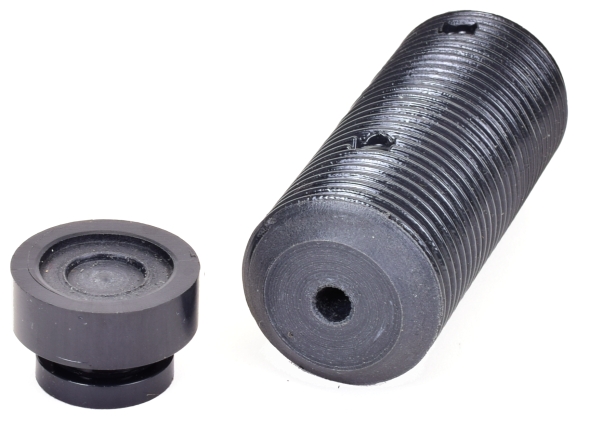
This tool set is sold for $12 to $15 by all of the folks who sell .30 caliber sabots. The base fits in the shell holder of a reloading press, the seating tool screws into a reloading press die head. The tool’s intent is to squarely seat bullet in a sabot in advance of seating that assembly in a finished cartridge, using a conventional seater die. There were a few problems in practice.
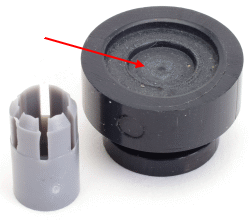 The recess in the base measured 0.307″ and it had a radius at the bottom of the center cut. As a result, sabots did not sit square in the base and bullet/sabot assemblies were not straight. The plastic bullet seater was at best imprecise and it didn’t improve with use.
The recess in the base measured 0.307″ and it had a radius at the bottom of the center cut. As a result, sabots did not sit square in the base and bullet/sabot assemblies were not straight. The plastic bullet seater was at best imprecise and it didn’t improve with use.
The base was clamped in the milling machine and cleaned up with a 5/16″ end mill. The 0.312″ recess was slightly larger than the sabot, but with improvements to the seater tool, the assembled pieces were consistently aligned. Actually, I could get the same results using a .223 Remington shell holder and just sitting the sabot over the pass through primer hole. The important thing was to stop the base from cocking the sabot.
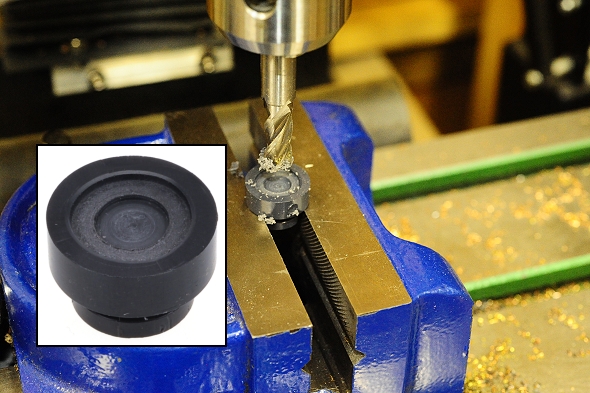
A die blank was drilled at the center 1″ deep x 0.150″ for bullet tip clearance, then a tapered stone in a rotary tool was used to put a slight radius at the hole entrance to open it up to approximately 0.170″. The use of a steel die, rather than the soft poly more uniformly located the bullet to the sabot.

No, a standard seater die will not work… thanks for asking
The instructions for the seater tool explains it is used only to assemble a bullet to a sabot and then that assembly is seated in a cartridge case using a conventional 30-06 Springfield seater die. Checking seater dies from three manufacturers: Hornady, RCBS and Redding clearly shows that this approach will either damage the bullet or the sabot depending in the bullet’s ogive geometry. The problem is that the .30 caliber seater plug within a seater die is way too big and does not properly contact and support a bullet while the sabot/bullet assembly is being seated.
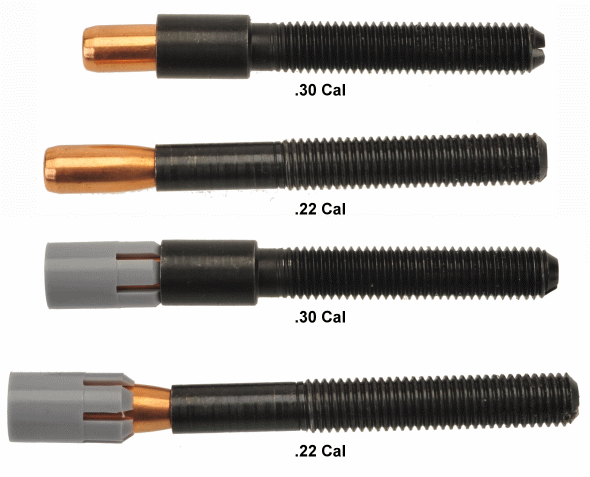
 As shown above with RCBS die parts, the .22 caliber bullet enters too far into the .30 caliber seater plug, which causes the bullet to jam in the die and/or severely damage the sabot by jamming the fingers against the plug. Using the plug that is correct for the bullet solves the problem. Plugs are available from the die manufacturer, they are easy to make from Lowes Home Improvement Center bolts or, as we did here, it is possible to borrow a .22 caliber seater plug from any .22 caliber centerfire seater die.
As shown above with RCBS die parts, the .22 caliber bullet enters too far into the .30 caliber seater plug, which causes the bullet to jam in the die and/or severely damage the sabot by jamming the fingers against the plug. Using the plug that is correct for the bullet solves the problem. Plugs are available from the die manufacturer, they are easy to make from Lowes Home Improvement Center bolts or, as we did here, it is possible to borrow a .22 caliber seater plug from any .22 caliber centerfire seater die.
Another step that helps seat saboted bullets without deformation and with improved bullet-case concentricity is flaring the case mouth as might be done when loading cast bullets. A good tool for the job is a Lee universal flaring die. Using the internal anvils in different positions and combinations allows the tool to work with virtually any length cartridge in calibers from .22 to .45.
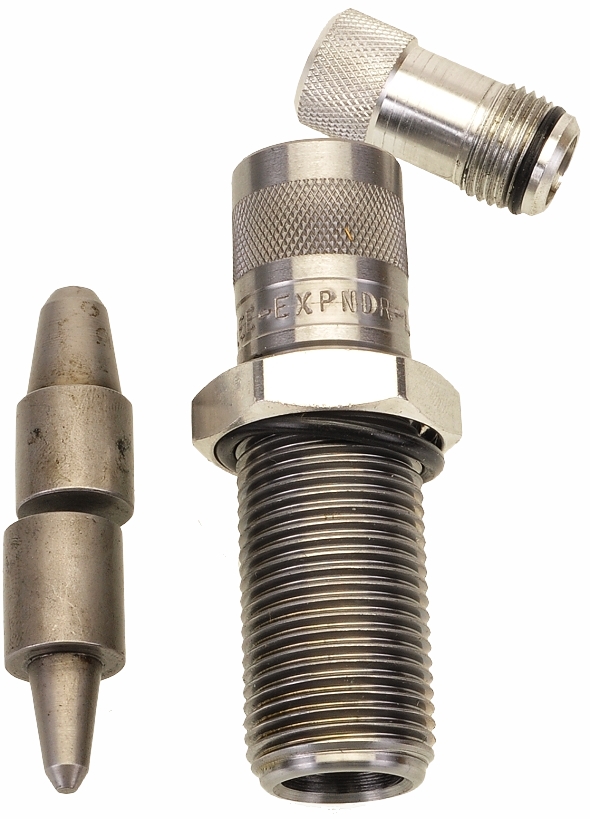
Last but not least…

Sabot product instructions suggest using flat base bullets, but I don’t know why. I opted for a more eclectic selection of bullets… but I don’t know why, other than I thought I would like to find out for myself in the absence of other information. All handloads received a very slight roll crimp to reform the flared case mouth.
|
Bullet |
Type | Listed Weight Grains |
Actual Weight Grains |
Sabot Weight Grains |
Total Weight Grains |
Overall Length Inches |
| Berger Varmint | FB | 50 | 50.0 | 5.9 | 55.9 | 0.832 |
| Sierra BlitzKing | BT | 50 | 50.0 | 5.9 | 55.9 | 0.894 |
| Speer TNT | FB | 50 | 49.9 | 5.9 | 55.8 | 0.800 |
| Remington PSP | FB | 55 | 55.4 | 5.9 | 61.3 | 0.801 |
| Hornady Match | BT | 68 | 68.1 | 5.9 | 74.0 | 1.090 |
 |
Warning: Bullet selections are specific, and loads are not valid with substitutions of different bullets of the same weight. Variations in bullet length will alter net case capacity, pressure and velocity. Primer selection is specific and primer types are not interchangeable. These are maximum loads in my firearms and may easily be excessive in others. All loads should be reduced by 5%, and developed following safe handloading practices as represented in established reloading manuals produced by component manufacturers. Presentation of these loads does not constitute a solicitation for their use, nor a recommendation.
|
||||||||||||||||||||||||||||||||||||||||||||||||||||||||||||||||||||||||||||||||||||||||||||||||||||||||||||||||||||||||||||||||||||||||||||||||||||||||||||||||||||||||||||||||||||
|
|||||||||||||||||||||||||||||||||||||||||||||||||||||||||||||||||||||||||||||||||||||||||||||||||||||||||||||||||||||||||||||||||||||||||||||||||||||||||||||||||||||||||||||||||||||
The reloading data offered with sabots is not reloading data at all, it is output from a program “Load From a Disk” that is no longer in production. Unlike QuickLoad predictive software that drives calculation based on the properties if each component including powder, Load From A Disk makes predictions based on bracketed types of powder with wide variations in energy within each bracket. Used as intended, start loads can typically be found, but many newer powder types are not considered within the program. Additionally, the suggestion was made to reference .22 caliber factory cartridges with larger capacity… which makes no sense because almost doesn’t count in handloading and pressure effects bullets of the same weight differently when they are of different diameters.
Within our project, components were weighed and measured and added to the QuickLoad database to arrive at start loads and then the loads progressed upward a bit to what was determined to be the ceiling for safe and/or useful loads.
Why? Why? Why?
At the end of the first two rounds of handloading this ammunition, that was about all that came to mind, “Why?”. A good deal of tedious work was required, information had to be pioneered and then the results were so-so. Sabots offer no cost benefit as a type of ammunition. Under the best circumstances, and accepting that bargains can be found for both .30 caliber and .22 caliber components, the savings potential is approximately 80 cents per box of 20 round and that savings evaporates quickly with the defect yield down on sabots and the large quantities of powder consumed when driving .22 caliber bullets to high velocity.
The third cycle of reloading, the first without having to fabricate tools or develop further load data, was actually a lot of fun. The Remington Model 700 barked and spit out quite a flame behind the sabot as it exited the barrel. There was little recoil and the little 0.224″ bullets really did a number on volunteer pumpkin targets. Accuracy was not bad at all but, no, the Remington Model 700 XCR II that shot less than 1″ routinely as a 30-06 Springfield, shot between 0.8″ and 2.0″ with sabot loads, very much dependent upon careful assembly and specific components selected.
Sabot loads are fun to work with and it is always interesting for a handloader to find new and useful ways to utilize a firearm, or to improve its performance. Getting sabot accuracy out of the 5″ range and down to the 1″ and a bit category gave me information that will carry over to more generalized handloading and hopefully bring improvement to that activity.
Sabots offer utility for folks who don’t mind the effort and expense and want 22-250 Rem or 220 Swift levels of performance from a 30-06 Springfield rifle and for anyone who wants to refine the process through experimentation. I’m sure there is potential for greater accuracy. In fact, I have some thoughts for a revised sabot design that may be the subject of a future article.
1) Cartridges of the World – 8th Edition – Barnes & McPherson Cartridges of the World #8 is in error, listing the .308 Winchester version as 3,800 fps as Remington product information indicates 3,770 fps. Later editions of Cartridges of the World omit the velocity reference.
2) Remington Sporting Arms and Ammunition Catalogs – Note: 30-06 Springfield Accelerator paused in 1996, but resumed through to the indicated last production date.

Email Notification